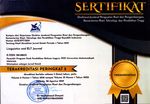Improving Students’ Reading Skill Through Think-Pair-Share (TPS) Technique
Abstract
This study aims at investigating how the Think-Pair-Share (TPS) technique can improve the students’ reading skill at the English Language Department, FKIP, Muhammadiyah University of Mataram. The problem found in the fourth-semester students is that they have low ability in comprehending the text. The TPS technique is offered by the researcher to solve the problem. Later on, the design of this research was classroom action research adopted from Kemmis & McTaggart which goes through a cycle that consists of four stages namely planning, acting, observing, and reflecting. At the cycle 1, the students failed to meet the criteria of success because only 14 (fourteen) out of 30 (thirty) or 47% students who got the minimum passing grade 75 (seventy-five) and the average score was 67. It meant that the study must be continued to the next cycle. At last, in the cycle 2 met the criteria of success in which 67% students or 20 (twenty) out of 30 (thirty) students met the minimum passing grade 75 and the average score was 72. Beside gaining improvement in the reading score, the students also seemed enthusiastic in thinking, pairing and sharing their ideas. They stated that this technique could encourage and motivate them in thinking, exploring and sharing their opinion and ideas. This technique is also good to enhance cooperation with other people. Finally, TPS technique also able to increase the students’ confidence to share their ideas in front of many people.
Keywords
Full Text:
PDFReferences
Abdurrahman. E, Susilawati, E, and Arifin, Z. (2012). Improving students’ ability in Reading Comprehension through Cooperative learning (Think-Pair-Share). Pontianak. Tanjung Pura University.
Anderson. (2003). Reading. In David Nunan (2003) Practical English Language Teaching (1st Edition) New York: McGraw Hill.
Arends, R. I. 1997. Introduction to Classroom Instruction and Management.
New York: McGraw-Hill Company, Inc.
Awad Raba, A.A. (2017). The Influence of Think-Pair-Share on Improving Students’ Oral Communication Skills in EFL Classrooms. Creative Education, Volume 8. 12-23.
Bamiro, Adekunle O. (2015). Effect of guided discovery and Think-Pair-Share Strategies on Secondary school students’ achievement in Cemistry. SAGE Open. January-March 1-7.
Harmer. J. (2007). How to teach writing. England: Pearson education limited.
Grabe, S. and Staller F. L. (2002). Teaching and Researching Reading. England: Longman.
Jannah, Nikmatul. (2013). The effectiveness of Think-Pair-Share Technique in Teaching Reading. Jurnal Penelitian, Pendidikan dan Pengajaran FKIP UNISMA Vol.1 N0 12.
Kagan, S & Kagan, M. (2009). Kagan Cooperative Learning. California: Kagan Publishing.
Kemmis, S. and R. McTaggart (eds). (1988). Action Research Planner 3rd Edition. Melbourne: Deakin University Press.
Narulaya, D.R. Nadrun, Budi. (2014). Increasing Reading Comprehension of the Eleventh grade students through Think-Pair-Share (TPS) technique. E-journal of English Language Teaching Society (ELTS) Vol. 2 No.1 ISSN 2331-1841.
Nejad, S.G. & Keshavarzi, A. (2015). The effect of Cooperative Learning on Reading Comprehension and Reading Anxiety of Pre-University Students. Journal of Applied Linguistics and Language Research, Volume 2, Issue 8, pp.169-180 ISSN: 2376-760X.
Nuttal, C. (1996). Teaching Reading Skills in a Foreign Language. Cambridge: Cambridge University Press.
Pattiiha, H.2006. An Application of the Think-Pair-Share to Improve the Implementation of the Learning of Beginning Reading Among Second Year Students at SDN Sumbersari II Malang. Unpublished Thesis of State University of Malang.
Rahvard, Z.J. (2010). Cooperative learning Strategies and Reading Comprehension. California Linguistic Notes. XXXV (2), 1-15.
Sampsel, Ariana. (2013). Finding the Effect of Think-Pair-Share on Student confidence and participation. Honors Project. Paper 28.
Shih, Y.C. & Reynold, B.L. (2015). Teaching Adolescents EFL by Integrating Think-Pair-Share and reading Strategy Instruction: A Quasy- Experimental Study. RELC Journal 1-15.
Slavin, R.E. (2011). Cooperative Learning. Teori, Riset, dan Praktik. Bandung: Nusa Media.
Sugiarto, D. & Sumarsono, P. (2014). The implementation of Think-Pair-Share Model to Improve students’ ability in reading Narrative Text. International Journal of English and Education Volume:3 Issues:3
Sukyadi, D & Hasanah, E.U. (2010). Scaffolding students’ reading comprehension with think-aloud strategy. Indonesia: The language center, Indonesia University Education.
Supriyono, Agus. (2013). Cooperative Learning. Teori dan Aplikasi Paikem. Yogyakarta. Pustaka Pelajar.
Tompkins, G.E., & Hoskinson. K. (1991). Language Art: Content and Teaching Strategies. New York: Macmillan Publishing Company.
Wallace, C. (1992). Reading. Cambridge: Oxford University Press.
Weaver, C. (1994). Reading Process and Practice. Portsmouth: Heinermann.
Wichadee, S. (2005). The effects of cooperative learning on English reading skill and attitudes of the first- year students at Bangkok University. BU academic Review, 4 (2), 22-31.
DOI: https://doi.org/10.31764/leltj.v12i2.746
Refbacks
- There are currently no refbacks.
Copyright (c) 2019 Linguistics and English Language Teaching Journal

This work is licensed under a Creative Commons Attribution-ShareAlike 4.0 International License.
_____________________________________________________
Linguistics and ELT Journal
p-ISSN 2339-2940 | e-ISSN 2614-8633

LELTJ is licensed under a Creative Commons Attribution-ShareAlike 4.0 International License.
_____________________________________________________
LELTJ is abstracting & indexing in the following databases:
_____________________________________________________
LELTJ Editorial Office:













